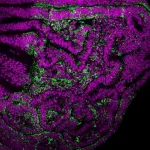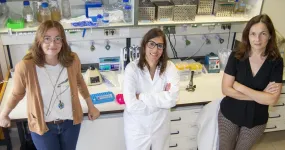(Press-News.org) By analyzing the genomes of 99 species of vinegar flies and evaluating their chemical odor profiles and sexual behaviors, researchers at the Max Planck Institute for Chemical Ecology show that sex pheromones and the corresponding olfactory channels in the insect brain evolve rapidly and independently. Female flies are able to recognize conspecific males through their specific odor profiles. Interestingly, closely related species show distinct differences in odor profiles, which helps to prevent mating between different species. Males, in turn, chemically mark females during mating so that they become less attractive to other males. The results of this study are a valuable basis for understanding how pheromone production, their perception and processing in the brain, and ultimately the resulting behavior drive the evolution of new species (Nature Communications, July 2021, DOI: 10.1038/s41467-021-24395-z).
A large family with extravagant relatives
As in most animals, mate choice in vinegar flies is primarily based on chemical signals. There are several reasons why the genus Drosophila is ideally suited for studying the evolution and diversity of sex pheromones. The more than 1.500 known species of vinegar flies are found all over the world in a wide variety of different habitats: in deserts, rainforests, caves, swamps, or mountains. Often, rotting fruit and the yeasts responsible for fermentation are the primary food source. Some species also feed on fresh fruit, mushrooms, tree bark, flowers, bacterial slime, or frog spawn. In many species, especially in the model organism Drosophila melanogaster, the processing of olfactory information in the brain has already been well described. The receptors for the sex pheromones are precisely tuned to detect the odor of the conspecific mating partner.
In a new study published now in Nature Communications, researchers led by Mohammed Khallaf and Markus Knaden investigated how sex pheromones evolved in 99 different species of the genus Drosophila. "We identified the sex pheromones and the corresponding olfactory channels in the olfactory system of flies to explore the evolution of pheromone signaling with respect to phylogenetic relationships," said Mohammed Khallaf, first author of the study. 41 of the species under investigation had already been fully sequenced. By sequencing the whole genomes of further 58 species, the scientists presented the most comprehensive phylogenetic analysis of the genus Drosophila to date.
By using the genomic data, it was possible to genetically compare differences in chemical profiles as well as differences in odor detection and processing. The researchers collected the odors of individual flies: Five males, virgin and mated females from each species, resulting in odors of over 1500 flies in total, were analyzed. "While the comparison of male and virgin female flies informed us about sex-specific differences, variations between mated and virgin females informed us about male-specific compounds transferred to females during mating," Markus Knaden, head of the project group Odor-guided Behavior in the Department of Evolutionary Neuroethology, summarized.
The difference lies in the detail
In all 99 fly species studied, 52 different odor compounds were identified. In 81 species, the scientists found pheromones that are only produced by male flies. Of these species, males produce 58 different odor blends, which can consist of up to seven individual odors. While the males attract attention with a sophisticated chemistry, it is ultimately the females who decide whether mating occurs or not. "Interestingly closely related species often show clear differences in their pheromone profile. At the same time, individual pheromones show up again and again along the phylogenetic tree. For example, males of 34 of the 99 species studied produce cis-vaccenyl-acetate (cVA), a well described Drosophila melanogaster pheromone. Most of the male-derived pheromones fulfill the same functions: Firstly, they attract females and secondly, they are transferred to the females during mating to make them smell less attractive to other males. This ensures the males' reproductive success," said Markus Knaden.
The significant differences in the pheromone profile of males of closely related species suggest that the selection pressure to prevent mating between these species that have evolved from a common ancestor is high. On the other hand, the fact that as many as 34 species produce cis-vaccenyl acetate as a sex pheromone shows that there may only be a limited number of genes responsible for pheromone production. As long as there is no pressure to mark a difference from an evolutionary perspective, different species produce the same pheromone.
A key observation is that it is mostly the male fly in the genus Drosophila that is the transmitter of the chemical signal, while the females, as receivers, recognize and interpret the signal. "The diversity and abundance of male-specific compounds compared to female ones is astonishing: Of the 52 different odor compounds, 43 are produced exclusively by males, while only 9 are produced by females. Moreover, 81 Drosophila species communicate via male pheromones, while only 15 species have specifically female pheromones," said Mohammed Khallaf.
From odor to behavior
The study is the first comprehensive analysis of the mating behaviors of a large number of Drosophila species. "While we were performing mating experiments we could already observe that some of the species showed very specific behaviors. Some of them were driven by olfaction and only started their mating dance when the partner had the right smell. Sometimes, however, the right wing pattern or the male's song also triggered the female's mating behavior," Bill Hansson, who heads the Department of Evolutionary Neuroethology where the study was performed, described the observations in the mating arena. Presumably, sex pheromones play a crucial role as the first cue to identify the right partner before mating. Once a female has been attracted and is ready to mate, other mating rituals may also be initiated, including dance, nuptial gift or song. The researchers will further evaluate the recorded mating experiments for future studies and hope that these materials motivate other research groups to take a closer look at the mating strategies of different drosophilids as well.
INFORMATION:
Original Publication:
Khallaf, M. A., Cui, R., Weißflog, J., Svatoš, A., Dweck, H., Valenzano, D. R., Hansson, B. S., Knaden, M. (2021). Large-scale characterization of sex pheromone communication systems in Drosophila. Nature Communications, DOI. 10.1038/s41467-021-24395-z
https://www.nature.com/articles/s41467-021-24395-z
250GB of raw data, including genome sequences (66 species), mating movies (1467 recordings), chemical profiles of virgin males, and virgin and mated females (over 1500 replicates; five replicates or more of each sex in all 99 species), and other supplementary data are available here: https://dx.doi.org/10.17617/3.5w
July 6, 2021 - Traumatic brain injury (TBI) has a major impact on the lives of affected patients and families. But it doesn't necessarily lead to an increased risk of marital instability, as two-thirds of patients with TBI are still married to the same partner 10 years after their injury, reports a study in the July/August issue of the Journal of Head Trauma Rehabilitation (JHTR). The official journal of the Brain Injury Association of America, JHTR is published in the Lippincott portfolio by Wolters Kluwer.
For marriages that do end, divorce most often occurs within the first year after TBI, according to the new research by Flora M. Hammond, MD, of Indiana University School of Medicine, Indianapolis, and colleagues. "Our data dispel ...
The onset of the Indian summer monsoon has been predicted three months ahead for the last 40 years with the highest precision up until today. The result indicates longer seasonal forecasts based on machine learning may be a way to mitigate the consequences of an erratic monsoon system under future global warming. Dr. Takahito Mitsui and Dr. Niklas Boers of the Potsdam Institute of Climate Impact Research (PIK Potsdam), Germany, published the results in Environmental Research Letters. The work is part of the European TiPES project, Coordinated from The Niels Bohr Institute, University of Copenhagen, Denmark and PIK Potsdam.
Millions of people as well as natural habitats depend on the ...
BOSTON - A novel therapy recently approved by the U.S. Food and Drug Administration for patients with Alzheimer's disease amid considerable controversy should not be prescribed by physicians off-label for cerebral amyloid angiopathy (CAA), a similar cerebrovascular condition, according to Steven Greenberg, MD, PhD, director of the Hemorrhagic Stroke Research Program at Massachusetts General Hospital (MGH) and president of the International Cerebral Amyloid Angiopathy Association (ICAAA). In a letter published in The Lancet Neurology, Greenberg and eight other officers of the association wrote that there is no clinical evidence that the monoclonal antibody aducanumab is beneficial to patients with CAA, a condition in which proteins known ...
Chromosomal instability is a feature of solid tumours such as carcinoma. Likewise, cellular senescence is a process that is highly related to cellular ageing and its link to cancer is becoming increasingly clear. Scientists led by ICREA researcher Dr. Marco Milán at IRB Barcelona have revealed the link between chromosomal instability and cellular senescence.
"Chromosomal instability and senescence are two characteristics common to most tumours, and yet it was not known how one related to the other. Our studies indicate that senescence may be one of the intermediate links between chromosomal alterations and cancer," says Dr. Milan, head of the Development and Growth Control laboratory at IRB Barcelona.
"The behaviour we saw in cells with chromosomal instability ...
(Boston)--During neuropsychological assessments, participants complete tasks designed to study memory and thinking. Based on their performance, the participants receive a score that researchers use to evaluate how well specific domains of their cognition are functioning.
Consider, though, two participants who achieve the same score on one of these paper-and-pencil neuropsychological tests. One took 60 seconds to complete the task and was writing the entire time; the other spent three minutes, and alternated between writing answers and staring off into space. If researchers ...
BOSTON -- As we age, our brains typically undergo a slow process of atrophy, causing less robust communication between various brain regions, which leads to declining memory and other cognitive functions. But a rare group of older individuals called "superagers" have been shown to learn and recall novel information as well as a 25-year-old. Investigators from Massachusetts General Hospital (MGH) have now identified the brain activity that underlies superagers' superior memory. "This is the first time we have images of the function of superagers' brains as they actively learn and remember new information," says Alexandra Touroutoglou, PhD, director of Imaging ...
Scientists at the University of Leeds have developed an approach that could help in the design of a new generation of synthetic biomaterials made from proteins.
The biomaterials could eventually have applications in joint repair or wound healing as well as other fields of healthcare and food production.
But one of the fundamental challenges is to control and fine tune the way protein building blocks assemble into complex protein networks that form the basis of biomaterials.
Scientists at Leeds are investigating how changes to the structure and mechanics of individual protein building blocks - changes at the nanoscale - can alter the structure and mechanics of the biomaterial ...
Two model studies document the probability of climate tipping in Earth subsystems. The findings support the urgency of restricting CO2 emissions as abrupt climate changes might be less predictable and more widespread in the climate system than anticipated. The work is part of the European TiPES project, coordinated by the University of Copenhagen, Denmark but was conducted by Professor Michael Ghil, Ecole Normale Supérieure, Paris, France and coauthours from The Royal Meteorological Institute of Belgium and Parthenope University of Naples, Italy.
Tipping could be imminent
It is often assumed climate change will proceed gradually as we increase the amounts of CO2 in ...
Streptococcus pneumoniae is a major human pathogen and a leading cause of several infectious diseases including pneumonia, the third-leading cause of death in Portugal. In Europe, S. pneumoniae is the most common cause of community-acquired bacterial pneumonia in adults. Still, very little is known about its colonization within this age group. A team of researchers from ITQB NOVA has now taken a crucial step to clarify the dynamics of carriage of this bacterium in adults.
This bacterium, also known as pneumococcus, can asymptomatically colonize the human upper respiratory tract. Colonization not only precedes diseases but is also essential for transmission. Even ...
In 2011, scientists confirmed a suspicion: There was a split in the local cosmos. Samples of the solar wind brought back to Earth by the Genesis mission definitively determined oxygen isotopes in the sun differ from those found on Earth, the moon and the other planets and satellites in the solar system.
Early in the solar system's history, material that would later coalesce into planets had been hit with a hefty dose of ultraviolet light, which can explain this difference. Where did it come from? Two theories emerged: Either the ultraviolet light came from our then-young sun, or it came from a large nearby star in the sun's stellar nursery.
Now, researchers from the lab of Ryan Ogliore, assistant professor of physics in Arts ...






